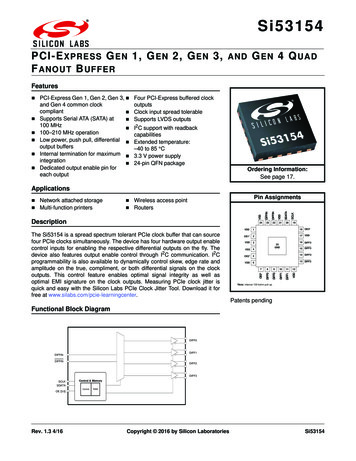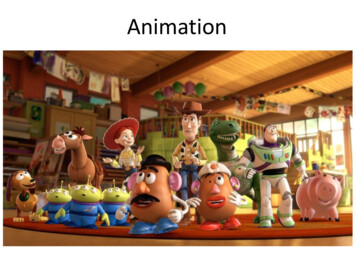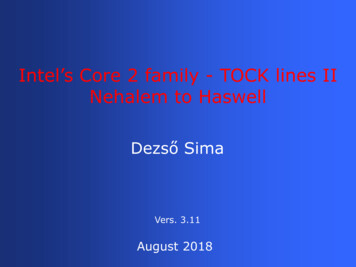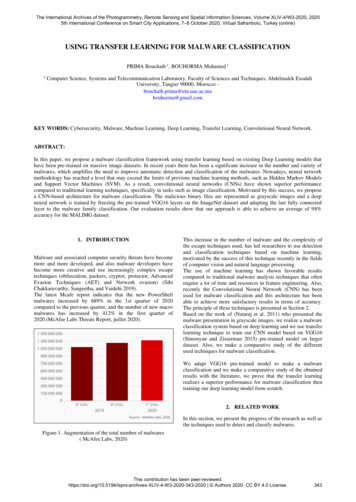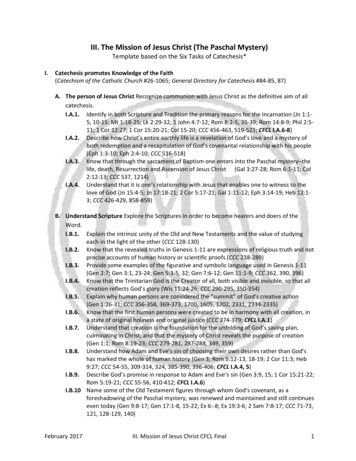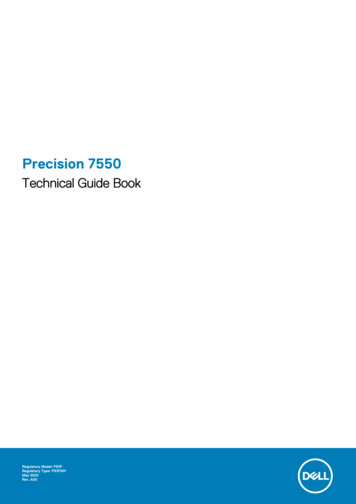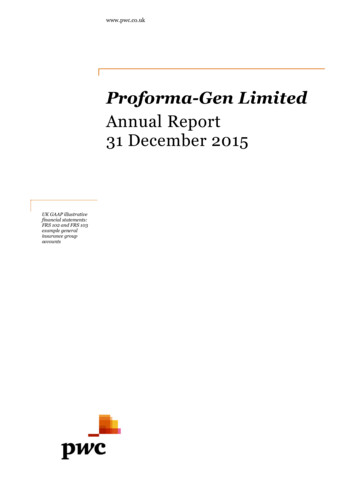
Transcription
www.pwc.co.ukProforma-Gen LimitedAnnual Report31 December 2015UK GAAP illustrativefinancial statements:FRS 102 and FRS 103example generalinsurance groupaccounts
Proforma-Gen LimitedPrefaceThis publication provides illustrative consolidated financial statements for a wholly owned private general insurance group, Proforma-GenLimited, for the year ended 31 December 2015. These illustrative financial statements will assist you in preparing financial statements byillustrating the required disclosure and presentation for a UK general insurance group reporting under FRS 102 ‘The Financial ReportingStandard, applicable in the UK and Republic of Ireland’ and FRS 103 “Insurance Contracts”.Significant components of this illustrative annual report include: The adoption of FRS 102 and FRS 103, including transition disclosures.The Strategic report and Directors report requirements for private companies.Illustrative auditor’s report for private companies reporting under FRS 102.Proforma-Gen Limited is a fictitious group. The annual report has been prepared for illustrative purposes only and shows the disclosuresand formats that might be expected for a general insurance company of its size that prepares its financial statements in accordance with therequirements of Part 15 of the Companies Act 2006 and the provisions of ‘The Large and Medium-sized Companies and Groups (Accountsand Reports) Regulations 2008’ (SI 2008/410) applicable to insurance groups.These financial statements also include voluntary disclosures that illustrate certain aspects of disclosure under FRS 102 and FRS 103.Proforma-Gen Limited is required to prepare a Strategic Report. It has prepared this on the basis of a private company.Annual Report 31 December 2015PwCi
Proforma-Gen LimitedIntroductionFormat of the financial statementsThe primary financial statements for insurers comprise: Income statement (profit and loss account) split into a technical and a non-technical account Statement of comprehensive income Statement of changes in equity (previously the statement of total recognised gains and losses, ‘STRGL’) Statement of financial position (balance sheet) Statement of cash flows (cash flow statement)Insurance companies and groups reporting under FRS 102 have to apply the prescribed formats for primary statements in Schedule 3 to theLarge and Medium-sized Companies and Groups (Accounts and Reports) Regulations 2008 (‘Schedule 3’) and therefore their incomestatement is split into a technical and a non-technical account.Reporting optionsFRS 102 requires firms to present their total comprehensive income in either a single ‘Statement of comprehensive income’, incorporatingall items of income and expense for the period or in two statements, an ‘Income statement’ (the profit and loss account) and a ‘Statement ofcomprehensive income’.If the only changes to equity during the periods for which financial statements are presented arise from profit or loss, payment of dividends,corrections of prior period errors, and changes in accounting policy, firms may present a combined Statement of income and retainedearnings in place of the Statement of comprehensive income and Statement of changes in equity.Proforma-Gen has chosen to present its total comprehensive income in two statements, a profit and loss account (split into a technical anda non-technical account) and a Statement of comprehensive income. Proforma-Gen has also prepared a separate Statement of changes inequity.Cash flow statementThe new cash flow statement has fewer standard headings than under old UK GAAP and shows movements in ‘cash equivalents’ as well ascash (cash in hand and deposits repayable on demand, less overdrafts).FRS 103 ‘Insurance contracts’The Financial Reporting Council (FRC) issued FRS 103, ‘Insurance contracts’, and accompanying implementation guidance (IG), on 20March 2014. FRS 103 applies to all entities adopting FRS 102 that issue insurance contracts. FRS 103 applies to insurance contracts(including reinsurance contracts) issued and reinsurance contracts held.Definition of an insurance contractThe definition of an insurance contract is the same as that contained in IFRS 4, which was previously used in old UK GAAP where FRS 26was applied.An insurance contractA contract under which one party (the insurer) accepts significant insurance risk from another party (the policyholder) by agreeing tocompensate the policyholder if a specified uncertain future event (the insured event) adversely affects the policyholder.Contracts falling within this definition are within the scope of FRS 103, regardless of whether they are regarded as insurance contracts forlegal or regulatory purposes. However, some specific types of contract falling within the definition of an insurance contract (such as productwarranties issued directly by a manufacturer, dealer or retailer) are excluded from the scope of FRS 103 and are accounted for under therelevant sections of FRS 102.FRS 103 also applies to issued financial instruments with discretionary participation features (DPF). In the UK, this includes with-profitscontracts that do not transfer significant insurance risk. Entities that have not previously adopted FRS 26 will be applying this definition ofan insurance contract for the first time and will need to ascertain which of their contracts fall within FRS 103’s scope and which contractsneed to be accounted for as financial instruments.Annual Report 31 December 2015PwCii
Proforma-Gen LimitedExisting practice continues, with scope for changes in accounting policyFRS 103 generally allows insurers to continue with current accounting practices for insurance contracts. This is subject to meeting someminimum requirements (for example, in respect of a liability adequacy test). In general, it is expected that old UK GAAP for regulatedinsurance contracts will meet these minimum requirements.FRS 103 provides the ability, as under IFRS 4, to make improvements (subject to legal and regulatory requirements) to existing accountingpolicies. That is, an accounting policy can be changed if the new policy makes the financial statements either more reliable and no lessrelevant, or more relevant and no less reliable.Translation of foreign currency denominated insurance contractsFRS 103 requires all assets and liabilities arising from an insurance contract to be treated as monetary items and so, where denominated ina foreign currency, these will be retranslated at each reporting date. Under old UK GAAP some balances arising out of insurance contracts,such as deferred acquisition costs and unearned premiums, were treated as non-monetary items and so were not retranslated (which gaverise to accounting mismatches where these contracts were backed with foreign currency denominated financial assets).Additional disclosures for insurersFRS 103’s disclosure requirements are largely based on those in IFRS 4. In addition some guidance previously contained in the ABI SORPhas been incorporated into FRS 103’s implementation guidance. More disclosures are likely to be required than old UK GAAP, includingclaims development tables and risk disclosures.FRS 103 transitional requirementsEntities applying FRS 103 can take advantage of the transitional requirements in FRS 103 Section 6 as follows:Claims development disclosuresAn insurer need not disclose information about claims development that occurred earlier than five years before the end of the first financialyear in which it applies FRS 103. Furthermore, if it is impracticable to prepare information about claims development that occurred beforethe beginning of the earliest period for which an entity presents full comparative information the entity shall disclose that fact.Re-designation of financial assetsIf an insurer changes its accounting policies for insurance liabilities, it is permitted, but not required, to reclassify some or all of its financialassets as a financial asset at fair value through profit or loss provided it meets certain requirements. This applies both on transition to FRS103 and on any subsequent changes in accounting policy.FRS 102, ‘The financial reporting standard applicable in the UK and Republic of Ireland’The FRC published FRS 102, ‘The financial reporting standard applicable in the UK and Republic of Ireland’, in March 2013. The standardapplies to accounting periods beginning on or after 1 January 2015 and is based on IFRS for SMEs, adapted to UK specific circumstances.Principal differences between FRS 102 and ‘old’ UK GAAPFRS 102 differs considerably from the previous version of UK GAAP. Most noticeably, it is much shorter and more concise. In terms ofaccounting treatments, the following are some of the principal differences:Financial instruments – recognition and measurement Under FRS 102, firms have an accounting policy choice when accounting for financial instruments. They can either apply therecognition and measurement provisions in FRS 102 (Section 11 and Section 12) or those in IAS 39 (as adopted in the EU) and/orIFRS 9. In practice many UK insurers reporting under old UK GAAP had previously applied FRS 26 (which mirrors IAS 39). Such insurersmay choose to apply the recognition and measurement provisions of IAS 39 to their financial instruments in order to preserveconsistency with reporting under ‘old’ UK GAAP. Proforma-Gen has chosen to apply the recognition and measurement provisions ofIAS 39 Financial Instruments: Recognition and Measurement (as adopted for use in the EU). For an example of the application ofthe recognition and measurement principles of Sections 11 and 12 of FRS 102 please refer to PwC’s FRS 102 example accountsavailable on PwC Inform.1PwC’s example accounts for FRS 102 can be found athttps://inform.pwc.com/inform2/s/UK GAAP illustrative financial statements UK GAAP FRS 102 example accounts/informContent/1519193502166525#ic 15191935021665251Annual Report 31 December 2015PwCiii
Proforma-Gen Limited Entities choosing to apply Section 11 and Section 12 of FRS 102 are required to determine which of its financial instruments arebasic, and which are not basic. They then apply different measurement requirements to financial instruments in each category:(a) Basic financial instruments are generally measured initially at transaction price, and subsequently at amortised cost using theeffective interest rate method. (b) Non-basic financial instruments are generally measured at fair value through profit or loss. Some of the main differences in accounting for financial instruments under FRS 102 Section 11 and Section 12 and old UK GAAPare as follows: Initial measurement of financial instruments varies between transaction price (excluding transaction costs) for those heldat fair value through profit or loss (FVTPL), present value of future payments for financing transactions, and transactionprice (including transaction costs) for those that are not held at FVTPL or financing transactions.Derivatives need to be fair valued and recognised on the balance sheet. This is a change for those not previously applyingFRS 26.Many equity investments need to be fair valued, with changes recognised through profit or loss.Hedged transactions cannot be recorded at the rate in matching contracts; new hedge accounting rules apply.Net investment hedging is not permitted in individual entity financial statements.Proforma-Gen is transitioning to new UK GAAP having previously applied FRS 26.Financial instruments – disclosures The disclosure requirements of FRS 102, Sections 11 and 12 must be followed irrespective of the accounting policy choice maderegarding the recognition and measurement of financial instruments. FRS 102 Section 34 sets out additional disclosure requirement for financial institutions (such as insurers) concerning an entity’sexposure to risk and how the entity manages those risks. Disclosures include: Significance of financial instruments for financial position and performanceImpairment reconciliation by class of financial assetAnalysis of the level in the fair value hierarchy into which fair value measurements are categorised by class of financialinstrumentNature and extent of risks arising from financial instruments: Credit risk Liquidity risk Market risk Capital managementDeferred tax Deferred tax needs to be recognised on asset revaluations, and on assets (except goodwill) and liabilities arising on a businesscombination. Under old UK GAAP deferred tax on asset revaluations was only recognised in respect of continuously revaluedassets where changes in value were recognised in profit and loss. Deferred taxes cannot be discounted.Goodwill and intangible assets All intangible assets, including goodwill, are assumed to have finite lives, so they have to be amortised. Intangibles with indefinitelives were possible under old UK GAAP. If an entity is unable to make a reliable estimate of the asset’s useful life, this should not exceed ten years; old UK GAAPpreviously specified 20 years. The definition of ‘intangible assets’ has changed. There could be more intangible assets recognised as part of a businesscombination.Proforma-Gen has recognised computer software as an intangible asset. Previously it was treated as a tangible fixed asset.Treatment of leviesUnder old UK GAAP, guidance in the ABI Statement of Recommended Practice on Accounting for Insurance Business (ABI SORP) mayhave led to levies based on premium income (e.g. those raised by the Financial Services Compensation Scheme and the Motor Insurers’Bureau) being recognised in line with the recognition in the financial statements of the premium by reference to which the levy iscalculated. Under FRS 102 Section 21 ‘Provisions and Contingencies’, an entity shall recognise a provision only when:(b)the entity has an obligation at the reporting date as a result of a past event;(c)it is probable (i.e. more likely than not) that the entity will be required to transfer economic benefits in settlement; and(d)the amount of the obligation can be estimated reliably.Insurers will need to assess the point at which these conditions are met when determining the point at which provision is made. Thiscould lead to a change to previous practice.Proforma-Gen has changed the basis on which it provides for levies. It now recognises a provision on the occurrence of the eventidentified by legislation that triggers the obligation to pay the levy. For example, for the Financial Services Compensation Scheme (FSCS)levy the triggering event is being a participating firm on 1 April of each year.Annual Report 31 December 2015PwCiv
Proforma-Gen LimitedEmployee benefits Interest and return on pension scheme assets is calculated as a net amount by applying the discount rate to the net pensiondeficit/surplus. ‘Expected return on assets’ will no longer apply. The deficit or surplus relating to a group defined benefit pension scheme can no longer be recognised only in the group accounts.Where group companies cannot individually account for their portion of the surplus/deficit, the total must be recognised in thesponsoring company’s accounts. A liability is recognised for multi-employer pension plans where there is an agreement to fund a deficit relating to past service,even if the plan is otherwise accounted for as defined contribution. Under FRS 17, there was no clear guidance in this situation. An accrual for short-term employee benefits (such as holiday pay) needs to be made.Other significant changes Groups are exempt from consolidating subsidiaries held as part of an investment portfolio; this is because these are considered tobe held for resale. All portfolio investments are measured at fair value through profit or loss. These subsidiaries would have beenconsolidated under old UK GAAP. Sales and purchases in a foreign currency can no longer be measured at the forward contract rate. Lease incentives are recognised over the lease term. Under old UK GAAP, lease incentives were spread over the shorter of thelease term and the period to the first market rent review. Run-off insurance business will no longer be presented as a discontinued operation as it does not meet the definition under FRS102. Under old UK GAAP, guidance in the ABI Statement of Recommended Practice on Accounting for Insurance Businessindicated that provision should be made for the full amount of any costs associated with running off the insurance business nolonger being written (after taking account of future investment return). Under new UK GAAP provisions will only be establishedto the extent that the criteria set out in FRS 102 Section 21 ‘Provisions and Contingencies’ are met. Proforma-Gen has reclassifiedits run-off aviation business as continuing and reassessed the provision established for the costs associated with running off thisbusiness. Entities that did not previously apply FRS 26 would have accounted for foreign exchange in accordance with SSAP 20 under oldUK GAAP. Under SSAP 20 the definition of a foreign branch included “a group of assets and liabilities which are accounted for inforeign currencies” and under this definition many insurers had classified their foreign currency denominated books of businessand backing assets as foreign branches. Under FRS 102 (as was the case under old UK GAAP for insurers applying FRS 23) thetreatment depends on the functional currency of foreign operations.FRS 102 transitional requirementsFor the purpose of first-time adoption, an entity’s date of transition to FRS 102 is the beginning of the earliest period for which the entitypresents full comparative information in its first financial statements that comply with FRS 102.Proforma-Gen is adopting FRS 102 for year ended 31 December 2015, and giving one year’s comparatives, so it has a date of transition of 1January 2014. It is not required to present the opening balance sheet (i.e. the balance sheet at the date of transition, 1 January 2014).The accounting policies that an entity uses in its opening balance sheet under FRS 102 might differ from those that it used under itsprevious financial reporting framework. The resulting adjustments are recognised directly in retained earnings (or, if appropriate, anothercategory of equity) at the date of transition.An entity adopting FRS 102 for the first time applies the transitional arrangements set out in FRS 102 Section 35. The underlying principleis retrospective application of FRS 102’s requirements. However there are some mandatory exceptions and optional exemptions from this.In particular, on first-time adoption of the FRS, an entity should not retrospectively change the accounting that it followed under itsprevious financial reporting framework for any of the following transactions: Financial assets and liabilities derecognised before the date of transition. Hedging relationships that no longer exist at the date of transition. Estimates – hindsight cannot be used to improve these. Discontinued operations meeting FRS 102’s definition – previous accounting is not changed. This transitional provision does notextend to operations that were accounted for as discontinued under ‘old’ UK GAAP but do not meet the FRS 102 definition of adiscontinued operation. Non-controlling interests – generally these are not changed on transition.Future developmentsThe FRC has released an exposure draft (FRED 64) which primarily seeks to remove references to PRA rules which are no longerapplicable. If approved these changes will be effective for accounting periods ending after 1 January 2016. The FRC also intends to reviewFRS 103 once the IASB has issued its updated standard on insurance contracts.Annual Report 31 December 2015PwCv
Proforma-Gen LimitedGuidance on the Strategic ReportThe strategic report was introduced in 2013 by the Department for Business, Innovation & Skills (‘BIS’) as part of its revised narrativereporting regulations. The Financial Reporting Council (FRC) published ‘Guidance on the Strategic Report’ in June 2014 to helpcompanies improve the overall quality of corporate reporting as they implemented the regulations. The guidance is written with therequirements for quoted companies in mind but the underlying concepts are intended to represent best practice for all companies requiredto prepare a strategic report. It is intended to have persuasive rather than mandatory force, so companies do not need to follow it orexplain where they have not done so.The guidance gives an overview of the various components of an annual report and considers where information should best be placed. Itaims to help companies think innovatively about communication. It also encourages companies to focus on ensuring disclosures arematerial, as a key step towards concise reporting.Proforma-Gen is required to prepare a Strategic Report. It has prepared this on the basis of a private company.Guidance and informationReferences to source material are given in the left-hand margin. PwC commentary on the accounting requirements is presented in shadedcommentary boxes. Best practice recommendations are provided where they are considered appropriate and helpful. The intention is notto show all conceivable disclosures and this annual report should not, therefore, be used as a checklist. The suggested disclosures are notnecessarily applicable for all private general insurance companies.This illustrative annual report does not cover the following sections of FRS 102 (amongst other items): Inventories (Section 13) Hyperinflation (Section 21). Government grants (Section 24). Impairment of assets (Section 27). Specialised activities, other than financial institutions (Section 34).If you require further guidance on the UK law and accounting requirements affecting insurers’ financial statements, the following PwCpublications may be of assistance: Manual of Accounting – New UK GAAP UK GAAP illustrative financial statements: FRS 102 example accountsThese can be ordered via manual-of-accounting-new-uk-gaap.jhtml.If you wish to discuss any aspect of insurance financial reporting, please contact either the author, Mike Vickery (0117 309 2403), or yourusual PwC contact.PricewaterhouseCoopers LLPLondonJanuary 2016Annual Report 31 December 2015PwCvi
Proforma-Gen LimitedProforma-Gen Limited is a fictitious group. The annual report has been prepared for illustrative purposes only and shows the disclosuresand formats that might be expected for an unlisted insurance group of its size that prepares its financial statements in accordance with therequirements of Part 15 of the Companies Act 2006 and The Large and Medium-sized Companies and Groups (Accounts and Reports)Regulations 2008 (SI 2008/410). The intention is not to show all conceivable disclosures and this annual report should not, therefore, beused as a checklist. The suggested disclosures are not necessarily applicable for all private companies.Annual Report 31 December 2015PwCvii
Proforma-Gen LimitedAbbreviationsSource references used in the illustrative annual report are abbreviated as follows:APB 2001/1The Auditing Practices Board Bulletin [reference]DVDisclosure voluntaryFRS 102, 3.2Financial Reporting Standard [number], [paragraph number]IG 2.1Implementation Guidance to accompany FRS 103 Insurance contracts [paragraph number]IAS 39, AGInternational Accounting Standard [number], Application guidance [paragraph number]PN20, 300Auditing Practices Board Practice Note [number], [paragraph number]PwCPricewaterhouseCoopers LLPs415Section number of the Companies Act 2006ISA 700International Standard on Auditing (UK and Ireland) [number]Sch7, 12Schedule number to The Large and Medium-sized Companies and Groups (Accounts and Reports)Regulations 2008 (“SI 2008/410”), [paragraph number]Sch3, Pt II, 1Part II of Schedule 3 to The Large and Medium-sized Companies and Groups (Accounts and Reports)Regulations 2008 (“SI 2008/410”), [paragraph number]Sch3 BS(4)Note on the balance sheet format within Schedule 3 to The Large and Medium-sized Companies and Groups(Accounts and Reports) Regulations 2008 (“SI 2008/410”) [number]Sch3 PL(9)Note on the profit and loss account format within Schedule 3 to The Large and Medium-sized Companies andGroups (Accounts and Reports) Regulations 2008 (“SI 2008/410”) [number]SI2008/410Statutory instrument [year/number]SEN 1Financial Reporting Council Staff Education Note [number]Tech 02/10, 3.3Technical release [number/year), [paragraph number] issued by the ICAEW and ICASAnnual Report 31 December 2015PwCviii
Proforma-Gen Limited(Registered Number: 00187936)Annual Report31 December 2015
Proforma-Gen LimitedContentsDirectors and Officers . 4Strategic report for the year ended 31 December 2015 . 5Directors’ report for the year ended 31 December 2015. 8Independent auditors’ report to the members of Proforma-Gen Limited .12Consolidated profit and loss account for the year ended 31 December 2015: Technical account – Generalbusiness .15Consolidated profit and loss account for the year ended 31 December 2015: Non-technical account.19Consolidated statement of comprehensive income for the year ended 31 December 2015 . 20Consolidated balance sheet as at 31 December 2015.21Company balance sheet as at 31 December 2015. 24Consolidated statement of changes in equity for the year ended 31 December 2015. 25Company statement of changes in equity for the year ended 31 December 2015. 26Consolidated statement of cash flows for the year ended 31 December 2015. 27Notes to the financial statements for the year ended 31 December 2015 . 28General information . 28Statement of compliance . 28Summary of significant accounting policies. 28Basis of preparation. 29Going concern . 29Exemptions for qualifying entities under FRS 102. 29Basis of consolidation . 30Foreign currency .31Insurance contracts . 32Exceptional items. 37Employee benefits. 37Taxation. 38Business combinations and goodwill. 39Intangible assets . 39Land and buildings . 40Tangible assets . 40Borrowing costs .41Leased assets .41Impairment of non-financial assets.41Investments – Company . 42Cash and cash equivalents. 42Provisions and contingencies.
It has prepared this on the basis of a private company. Proforma-Gen Limited Annual Report 31 December 2015 . The Financial Reporting Council (FRC) issued FRS 103, 'Insurance contracts', and accompanying implementation guidance (IG), on 20 . Deferred tax needs to be recognised on asset revaluations, and on assets (except goodwill) and .
